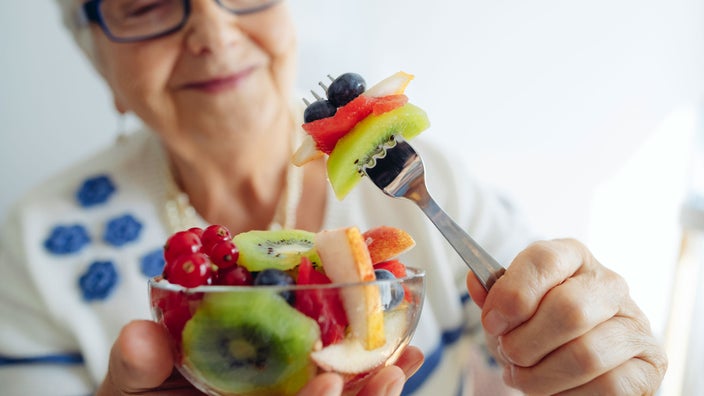
12 Super Healthy and Nutritious Fruits With Proven Benefits
Key takeaways:
Fruits are an excellent source of fiber and vitamins, which are good for your body and overall health. They’re naturally low in salt, fat, and added sugar.
While all fruits are good for you, some have strong scientific evidence of specific and advanced health benefits. Examples range from lemons, blueberries, and apples to oranges, raspberries, pomegranates, and grapefruit.
You can get the health benefits from fruit in a variety of forms — fresh, frozen, canned, or freeze-dried. Even 100% fruit juice still offers some health benefits.
Table of contents

Most people know that eating fruit is an important part of a balanced diet. But sometimes, fruit gets a bad rap — especially with diets that emphasize low sugar intake. You may have heard that the sugar in fruit makes it a less healthful option.
Keep in mind that the “best” fruit is usually the one you enjoy eating and that fits your individual health goals. We’ll explore how the natural sugars in fruit are different from artificial sugars and how to get the maximum benefit from the fruits you eat.
Here are the top 12 fruits that stand up to the rigors of scientific studies.
Save over 40% on Qsymia with GoodRx
Discover the once daily Qsymia for weight management. Qsymia is for adults and children 12-17 in combination with a healthy diet and regular exercise.

1. Lemons
Turning lemons into lemonade can do more than just boost your spirits. In a 2014 study on the most nutrient-dense fruit, lemons came out as the top citrus fruit.
Lemons (or lemon juice) have been found to help:
Keep in mind: To get the full benefits of lemons, be sure to keep the pulp in the juice. There are lots of ways to use both lemon juice and its pulp, including smoothies, lemon scones, and lemon-based salad dressings.
2. Blueberries
Blueberries contain anthocyanins, the special pigments that give them their rich color. They also have anti-inflammatory and antioxidant properties. Studies show that blueberries reduce the risk of:
Heart disease
Type 2 diabetes
Obesity
High blood pressure
One small study found that blueberries reduce depression symptoms in adolescents and young adults. But more research is needed in this area. Blueberries may also help protect your brain from the effects of aging and improve brain function.
3. Apples
It turns out that an apple a day really can help keep the doctor away. Apples are another “super fruit” with wide-ranging health benefits. These include a protective effect against cancer, Alzheimer’s disease, and asthma.
There are lots of apple varieties, so it’s hard to say if there’s a “healthiest” apple. That said, one study found that Fuji and Red Delicious apples had particularly high amounts of phytochemicals with antioxidant properties.
Is dried fruit good for you? Yes, in moderation. A dietitian shares the health benefits of dried fruit and what to keep in mind.
Looking for a high-fiber fruit? Fiber is a key part of what makes fruit a staple in a balanced diet. These fruits are packed with fiber.
What is fruit sugar? Lots of ultra-processed foods have added sugar. Learn how this is different from the sugar in fruit.
4. Oranges
One large orange provides the recommended daily amount of vitamin C. But that’s not all. Citrus fruits like oranges also contain flavanones. These can help improve cognitive performance and keep your heart healthy.
5. Cherries
Like blueberries, cherries contain anthocyanins. Studies show their antioxidant powers have health benefits. Tart cherries, in particular, have also been linked to:
Reduced exercise-induced muscle damage in athletes
Better sleep due to its melatonin (sleep hormone) content
Read more like this
Explore these related articles, suggested for readers like you.
6. Pomegranates
Pomegranate seeds are tiny, but they pack a big punch. Studies show that pomegranates can reduce the risk of diabetes and high blood pressure, among other benefits. Pomegranates are also rich in polyphenols, which have antioxidant and anti-inflammatory effects.
While animal studies have shown that pomegranate juice can help treat chronic inflammatory diseases like inflammatory bowel disease (IBD), more studies are needed to fully understand its potential health benefits for humans.
7. Grapefruits
Grapefruit is a powerhouse fruit with a low glycemic index and low calories. It’s also packed with furanocoumarins — compounds that fight cancer and promote bone health.
8. Tomatoes
Yes, tomatoes are a fruit and a delicious addition to a burger or part of your favorite spaghetti sauce. In the above-mentioned 2014 study, they beat out lemons in nutrient-density quality.
Tomatoes provide multiple health benefits due to their phytochemicals and nutrients, like potassium, folate, and vitamin C. Tomatoes also have lots of lycopene, a carotenoid that gives tomatoes their red color.
Lycopene is also a powerful antioxidant, and experts think it provides many of the tomato’s health benefits. Some of these benefits include:
Cardiovascular disease prevention
Improved gut health
Improved skin health
9. Avocado
Avocados are rich in monounsaturated fats, like oleic acid. They’re also a good source of fiber and potassium. Avocados provide many health benefits, including improving cholesterol, gut health, and brain function.
There are lots of easy and fun ways to use avocado, including guacamole. Add some tomato, and you have a tasty and nutrient-dense snack.
10. Strawberries
Strawberries are a nice topping for lots of different foods. They have good nutrient density, high fiber, and low sugar content. Like blueberries, they contain the plant chemical anthocyanin, with its antioxidant and anti-inflammatory properties.
One study looked at people born female who ate more than three servings of strawberries and blueberries each week. The study followed these people over 18 years and found they had a lower incidence of heart attacks.
Strawberries also appear to have cancer-fighting properties. And one study found their anti-inflammatory effects improved arthritis pain in people with a BMI over 30.
11. Pineapple
Pineapple is a tropical fruit favorite, rich in:
Fiber
Vitamins
Minerals
Pineapple also contains bromelain, a protein that helps break down foods.
A small study in the Philippines found that kids who consumed more canned pineapple had fewer illnesses.
In one study, bromelin-based gels helped with burn care. Oral bromelain also seemed to help with pain management and swelling after oral surgery.
12. Watermelon
As its name states, watermelon is a good source of water. Snacking on watermelon is a great way to stay hydrated and refreshed when the temperatures rise.
Watermelon is also a good source of vitamin A, vitamin C, and other antioxidants. Like tomatoes, it’s rich in lycopene. It also has the amino acid citrulline.
One study found that watermelon improves chemical markers associated with atherosclerosis. Another study showed it improved blood pressure and reduced body weight in people who are considered overweight and obese. Research also reveals watermelon extracts have anti-cancer properties.
Is all fruit healthy?
Yes. Studies show that fruit has a wide variety of health benefits — from reducing the risk of heart disease to helping with weight management.
Some of the things that make fruits good for you include:
Low salt content
No harmful fats or added sugar
High fiber content
Prebiotics and essential nutrients your body needs
Phytochemicals, or naturally occurring compounds in plants that often have antioxidant and anti-inflammatory properties
Experts agree, too. The FDA updated its definition of “healthy” and focused on nutrient-rich foods. Under their definition, all whole fruits qualify as healthy.
Is the sugar in fruit good for you?
The sugar in fruit isn’t unhealthy like added sugars. Fruits contain natural sugar in the form of fructose and/or glucose. These natural sugars are different from the artificial sugars added to processed foods.
Natural sugars don’t cause your blood sugar to spike as rapidly as artificial sugars. Fruits also contain fiber, which slows digestion and helps your body process the sugar in a healthy way.
What makes certain fruits ‘healthier’ than others?
Even though all fruits are good for you, some may have more health benefits than others. Depending on your specific health goals, there are many ways to look at what makes a fruit “healthy.”
Here are some ways to define the healthiest fruits:
Nutrient density: This refers to how many nutrients (especially vitamins and minerals) a fruit contains. Citrus fruits, for example, are especially rich in vitamin C.
Glycemic index: This measures how quickly a food increases your blood sugar. This is most relevant for people with diabetes or those with a higher risk of diabetes who may want to reach for fruits with a low-glycemic index.
Calories: While fruits are generally a low-calorie food, some have more calories than others. This might be helpful to consider for people trying to lose or gain weight.
Specific nutrients: Researchers are learning more and more about the unique nutrients in different fruits — such as anthocyanins in blueberries — and how those nutrients provide specific health benefits.
Which fruits are best for weight loss?
Some people focused on weight loss prefer to eat fruit that helps them feel full while reducing calorie intake. Examples of low-calorie fruits include:
Cantaloupe
Peaches
Watermelon
Strawberries
Grapefruit
Which fruits are best for people with diabetes?
People with diabetes may benefit from fruits that are lowest on the glycemic index. These include:
Blackberries
Apples
Grapefruit
Oranges
Cherries
Strawberries
Should I avoid certain fruit if I’m taking medication?
If you’re taking medication, you should ask your healthcare team about possible interactions with food. In particular, grapefruit (and grapefruit juice) is known to interact with multiple types of medications.
How does nutritional value change between forms of fruit?
Many people think fresh is best. But there are a lot of ways to get the health benefits from fruit:
Frozen fruit has all the same benefits as fresh fruit. In some cases, it may even preserve nutrients better than fresh fruit.
Canned and preserved fruit also has the same nutritional value. Just be sure to avoid products with added sugar.
Freeze-dried fruit loses some of the water-soluble nutrients. But it keeps about 90% of its nutrients.
Dried (dehydrated) fruit also keeps most of its nutrients. But watch out for added sugar — especially in fruits like cranberries, mangos, and pineapples.
Fruit juice is often missing fiber, so you’ll be missing out on those digestive benefits. Stick with 100% fruit juice to get a good amount of nutrition. That said, too much juice — even without added sugar — can still cause bigger spikes in your blood sugar.
Frequently asked questions
No fruits are unhealthy. But people with certain health conditions or medications may need to watch their fruit intake. As we noted above, people with diabetes should eat fruits with a lower glycemic index. And people should avoid grapefruit or its juice when they take certain medications.
Fiber is a non-digestible carbohydrate that improves digestion and gut health, helps control blood sugar, and lowers cholesterol. Fruits, in general, are high in fiber. Some of the fruits highest in fiber include:
Passion fruit
Avocado
Guava
Raspberries
Blackberries
The USDA certifies foods as organic if they’re grown without pesticides, among other requirements. Organic foods must also be non-GMO to be labeled as organic. Non-GMO foods haven’t undergone any genetic changes as part of their production.
Researchers haven’t found definitive evidence that organic or non-GMO foods have more health benefits than conventionally produced foods. The Academy of Nutrition and Dietetics reports that the nutritional value of organic, non-GMO, and conventional foods is similar.
The bottom line
Researchers are still uncovering all of the ways that fruit can benefit your health. From cancer prevention to heart health, studies show that fruits have a wide range of nutrients and health benefits. Since you can get the same health benefits from fresh, frozen, dried, or canned fruit, it’s easier than ever to find ways to enjoy those sweet bursts of healthy flavor.
Why trust our experts?



References
Aiken, C. (2021). Blueberries treat depression, with a catch. Psychiatric Times.
Bouzari, A., et al. (2015). Vitamin retention in eight fruits and vegetables: A comparison of refrigerated and frozen storage. Journal of Agricultural and Food Chemistry.
Boyer, J., et al. (2004). Apple phytochemicals and their health benefits. Nutrition Journal.
Brown, M. A., et al. (2019). Montmorency tart cherry (Prunus cerasus L.) supplementation accelerates recovery from exercise-induced muscle damage in females. European Journal of Sports Science.
Cassidy, A., et al. (2013). High anthocyanin intake is associated with a reduced risk of myocardial infarction in young and middle-aged women. Circulation.
Cervo, M. M. C. (2014). Effects of canned pineapple consumption on nutritional status, immunomodulation, and physical health of selected school children. Journal of Nutrition and Metabolism.
Cochran, N. (n.d.). GMO, conventional, organic: Why there’s more similarity than you think. Nutrition Education for the Public.
Colletti, A., et al. (2024). An evaluation of the effects of pineapple-extract and bromelain-based treatment after mandibular third molar surgery: A randomized three-arm clinical study. Nutrients.
Collins, E. J., et al. (2022). Tomatoes: An extensive review of the associated health impacts of tomatoes and factors that can affect their cultivation. Biology.
Cory, H., et al. (2018). The role of polyphenols in human health and food systems: A mini-review. Frontiers in Nutrition.
Danesi, F., et al. (2017). Could pomegranate juice help in the control of inflammatory diseases? Nutrients.
Di Noia, J., et al. (2014). Defining powerhouse fruits and vegetables: A nutrient dense approach. Centers for Disease Control and Prevention.
Dreher, M. L. (2018). Whole fruits and fruit fiber emerging health effects. Nutrients.
Fisk, J., et al. (2020). Effect of 4 weeks daily wild blueberry supplementation on symptoms of depression in adolescents. The British Journal of Nutrition.
FoodData Central. (2019). Oranges, raw, all commercial varieties. U.S. Department of Agriculture.
FoodData Central. (2019). Papayas, raw. U.S. Department of Agriculture.
FoodData Central. (2019). Pineapple, raw, all varieties. U.S. Department of Agriculture.
Gholami, A., et al. (2022). The beneficial effect of tart cherry on plasma levels of inflammatory mediators (not recovery after exercise): A systematic review and meta-analysis on randomized clinical trials. Complementary Therapies in Medicine.
Gu, I., et al. (2023). Bioavailability of citrulline in watermelon flesh, rind, and skin using a human intestinal epithelial caco-2 cell model. Applied Sciences.
Hung, W., et al. (2016). Chemistry and health effects of furanocoumarins in grapefruit. Journal of Food and Drug Analysis.
Hyson, D. A. (2011). A comprehensive review of apples and apple components and their relationship to human health. Advances in Nutrition.
Hyson, D. A. (2015). A review and critical analysis of the scientific literature related to 100% fruit juice and human health. Advances in Nutrition.
Ito, T., et al. (2018). Phytol isolated from watermelon (Citrullus lanatus) sprouts induces cell death in human T-lymphoid cell line Jurkat cells via S-phase cell cycle arrest. Food and Chemical Toxicology.
Kalt, W., et al. (2019). Recent research on health benefits of blueberries and their anthocyanins. Advances in Nutrition.
Kato, Y., et al. (2014). Effect on blood pressure of daily lemon ingestion and walking. Journal of Nutrition and Metabolism.
Khan, U. M., et al. (2021). Lycopene: Food sources, biological activities, and human health benefits. Oxidative Medicine and Cellular Longevity.
Krieger, Y., et al. (2017). Bromelain-based enzymatic debridement and minimal invasive modality (MIM) care of deeply burned hands. Annals of Burns and Fire Disasters.
Lu, X. H., et al. (2014). Physico-chemical properties, antioxidant activity and mineral contents of pineapple genotypes grown in China. Molecules.
Lum, T., et al. (2019). Effects of fresh watermelon consumption on the acute satiety response and cardiometabolic risk factors in overweight and obese adults. Nutrients.
Manetti, S., et al. (2024). Facts about monounsaturated fats. MedlinePlus.
Manivannan, A., et al. (2020). Versatile nutraceutical potentials of watermelon-A modest fruit loaded with pharmaceutically valuable phytochemicals. Molecules.
Miles, E. A., et al. (2021). Effects of citrus fruit juices and their bioactive components on inflammation and immunity: A narrative review. Frontiers in Immunology.
Ozkan, G., et al. (2023). A mechanistic updated overview on lycopene as potential anticancer agent. Biomedicine & Pharmacology.
Pan, X., et al. (2022). Preventive mechanism of lycopene on intestinal toxicity caused by cyclophosphamide chemotherapy in mice by regulating TLR4-MyD88/TRIF-TRAF6 signaling pathway and gut-liver axis. Nutrients.
Penniston, K. L., et al. (2008). Quantitative assessment of citric acid in lemon juice, lime juice, and commercially-available fruit juice products. Journal of Endourology.
Pontifex, M. G., et al. (2021). Citrus polyphenols in brain health and disease: Current perspectives. Frontiers in Neuroscience.
Przybylska, S., et al. (2022). Lycopene in the prevention of cardiovascular diseases. International Journal of Molecular Sciences.
Schell, J., et al. (2017). Strawberries improve pain and inflammation in obese adults with radiographic evidence of knee osteoarthritis. Nutrients.
Serna-Cock, L., et al. (2015). Structural, physical, functional and nutraceutical changes of freeze-dried fruit. African Journal of Biotechnology.
Shanely, R. A., et al. (2020). Daily watermelon consumption decreases plasma sVCAM-1 levels in overweight and obese postmenopausal women. Nutrition Research.
Speer, H., et al. (2020). Anthocyanins and human health—a focus on oxidative stress, inflammation and disease. Antioxidants.
Sueakham, T., et al. (2018). Anti-proliferative effect of Thai watermelon leaf extracts on cervical and breast cancer cells. International Journal of Science.
Testai, L., et al. (2017). Nutraceutical value of citrus flavanones and their implications in cardiovascular disease. Nutrients.
U.S. Department of Agriculture. (n.d.). About organic labeling.
U.S. Food and Drug Administration. (2017). Raw fruits poster (text version / accessible version).
U.S. Food and Drug Administration. (2024). Use of the term healthy on food labeling.
Varilla, C., et al. (2021). Bromelain, a group of pineapple proteolytic complex enzymes (ananas comosus) and their possible therapeutic and clinical effects: A summary. Foods.
Vigar, V., et al. (2019). A systematic review of organic versus conventional food consumption: Is there a measurable benefit on human health? Nutrients.
Vučić, V., et al. (2019). Composition and potential health benefits of pomegranate: A review. Current Pharmaceutical Design.
Zhang, X., et al. (2023). The effect of tomato and lycopene on clinical characteristics and molecular markers of UV-induced skin deterioration: A systematic review and meta-analysis of intervention trials. Critical Reviews in Food Science and Nutrition.





























